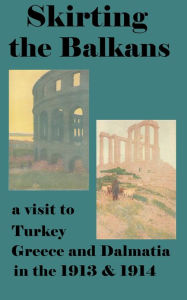Skirting the Balkans Traveling from Athens to Constantinople in 1912
Skirting the Balkans Traveling from Athens to Constantinople in 1912
2020-04-21 04:37:15
Skirting the Balkans Traveling from Athens to Constantinople in 1912
Skirting the Balkans Traveling from Athens to Constantinople in 1912
2020-04-21 04:37:15
The year was 1913.The First Balkan War between the Balkan League (Greece, Serbia, Montenegro, and Bulgaria) and the Ottoman Empire was just taking hold. Suspicious visitors everywhere were constantly being accused of being spies.Against this backgro...
Read more
The year was 1913.The First Balkan War between the Balkan League (Greece, Serbia, Montenegro, and Bulgaria) and the Ottoman Empire was just taking hold. Suspicious visitors everywhere were constantly being accused of being spies.Against this background, journalist, adventurer Robert Hichens decided to visit the Balkans, adventuring from Triest to Constantinople. What follows is a fascinating account of his travels, the people he meets, the time, and the ancient monuments he encounters.In Constantinople, he describes Santa Sophia –“Santa Sophia has nine gates leading to it from a great corridor or outer hall, lined with marble and roofed with old-gold mosaic. As you enter from the Porta Basilica, you have an impression of pale yellow, gold, and gray; of a pervading silvery glimmer; of a pervading gleam of delicate primrose, brightly pure and warm. You hear a sound of the falling of water from the two fountains of ablution, great vases of gray marble which are just within the mosque.“Gray and gold prevail in the color scheme, a beautiful combination of which the eyes are never tired. But many hues are mingled with them: yellow and black, deep plum-color and red, green, brown, and very dark blue. The windows, which are heavily grated, have no painted glass, so the mosque is not dark. It has a sort of lovely and delicate dimness, as touching as the dimness of twilight. It is divinely calm, almost as nature can be when she would bring her healing to the unquiet human spirit. We know that during the recent war Santa Sophia was crowded with suffering fugitives, with dying soldiers and cholera patients. I feel that even upon them in their agony it must have shed rays of comfort, into their hearts a belief in a far-off compassion waiting the appointed time to make itself fully manifest.“The great dome is of gold and of either black or very deep blue. Myriads of chandeliers, holding tiny glass cups, hang from the roof. Pale-yellow matting covers the plain of the floor. The silvery glimmer comes from the thousands of cups, the primrose gleam from the matting. The walls are lined with slabs of exquisite marble of many patterns and colors. Gold mosaic decorates the roof and the domes. Galleries, supported by marble arcades, and leaning on roofs of dim gold, run round a great part of the mosque, which is subtly broken up and made mysterious, enticing, and various by curved recesses of marble, by innumerable arches, some large and heavy, some fragile and delicate, by screens, and by forests of columns. Two-storied aisles flank the vast nave, through which men wander, looking almost like little dolls. So huge is the mosque that the eyes are deceived within it, and can no longer measure heights or breadths with accuracy. When I first stood in the nave I thought the chandeliers were hanging so near to the ground that it must be dangerous for a tall man to try to pass underneath them. They are, of course, really far higher than the head of a giant.“In Santa Sophia intricacy, by some magical process of genius, results in simplicity.”In Athens, of the Acropolis – “It is evident to anyone who examines this great theater carefully that the Greeks considered it important for the body to be at ease while the mind was at work; for not only are the seats perfectly adapted to their purpose, but ample room is given for the feet of the spectators, the distance between each tier, and the tier above it being wide enough to do away with all fear of crowding and inconvenience. The marble arm-chairs were assigned to priests, whose names are carved upon them. In the theater I saw one high arm-chair, like a throne, with lion's feet. This is Roman, and was the seat of a Roman general. The fronts of the seats are pierced with small holes, which allow the rain-water to es-cape. Below the stage there are some sculptured figures, most of them headless. One which is not is a very striking and powerful, though almost sinister, old man, in a crouching posture. His rather round forehead resembles the very characteristic foreheads of the Montenegrins.”On Greece itself – “What is the magic of pastoral Greece? What is it that gives to you a sensation of being gently released from the cares of life and the boredom of modern civilization, with its often unmeaning complications, its unnecessary luxuries, its noisy self-satisfactions? This is not the tremendous, the spectacular release of the desert, an almost savage tearing away of bonds. Nothing in the Greece I saw is savage; scarcely anything is spectacular. But, oh, the bright simplicity of the life and the country along the way to Marathon! It was like an early world. One looked, and longed to live in those happy woods like the Turkish Gypsies. Could life offer anything better?
Less
















.jpeg)



.jpg)








